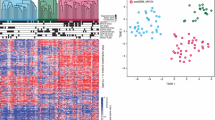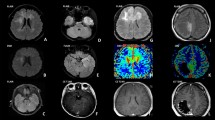Abstract
In contrast to the relative morphological uniformity of histone H3 K27-mutant high-grade gliomas, H3 G34-mutant tumors present as a histopathologically heterogeneous group of neoplasms, with microscopic characteristics typical of either glioblastoma (GBM) or central nervous system primitive neuroectodermal tumors (CNS-PNET). In the current study, we performed an integrative clinical, histopathological and molecular analysis of 81 G34-mutant CNS tumors. Routinely prepared tumor tissues were investigated for genomic and epigenomic alterations. Despite their divergent histopathological appearance, CNS tumors with H3.3 G34 mutations displayed uniform epigenetic signatures, suggesting a single biological origin. Comparative cytogenetic analysis with other GBM subtypes disclosed a high frequency and high specificity of 3q and 4q loss across G34-mutant tumors. PDGFRA amplification was more common in cases with GBM than with PNET morphology (36 vs. 5 %, respectively), while CCND2 amplifications showed the opposite trend (5 vs. 27 %). Survival analysis revealed the presence of amplified oncogene(s) and MGMT methylation as independent prognostic markers for poor and favorable outcomes, respectively. No difference in outcome was found between morphological variants (GBM vs. PNET). Thus, different histological variants of G34-mutant CNS tumors likely comprise a single biological entity (high-grade glioma with H3 G34 mutation, HGG_G34), which should be outlined in future diagnostic and therapeutic classifications. Screening for H3.3 G34 mutation should therefore be recommended as a routine diagnostic marker for supratentorial CNS tumors across a broad histological spectrum.




Similar content being viewed by others
References
Bady P, Sciuscio D, Diserens AC et al (2012) MGMT methylation analysis of glioblastoma on the Infinium methylation BeadChip identifies two distinct CpG regions associated with gene silencing and outcome, yielding a prediction model for comparisons across datasets, tumor grades, and CIMP-status. Acta Neuropathol 124(4):547–560. doi:10.1007/s00401-012-1016-2
Behjati S, Tarpey PS, Presneau N et al (2013) Distinct H3F3A and H3F3B driver mutations define chondroblastoma and giant cell tumor of bone. Nat Genet 45(12):1479–1482. doi:10.1038/ng.2814
Bender S, Tang Y, Lindroth AM et al (2013) Reduced H3K27me3 and DNA hypomethylation are major drivers of gene expression in K27M mutant pediatric high-grade gliomas. Cancer Cell 24(5):660–672. doi:10.1016/j.ccr.2013.10.006
Bjerke L, Mackay A, Nandhabalan M et al (2013) Histone H3.3 mutations drive pediatric glioblastoma through upregulation of MYCN. Cancer Discov 3(5):512–519
Brennan CW, Verhaak RG, McKenna A et al (2013) The somatic genomic landscape of glioblastoma. Cell 155(2):462–477. doi:10.1016/j.cell.2013.09.034
Cohen KJ, Pollack IF, Zhou T et al (2011) Temozolomide in the treatment of high-grade gliomas in children: a report from the Children’s Oncology Group. Neuro Oncol 13(3):317–323. doi:10.1093/neuonc/noq205
Duffner PK, Horowitz ME, Krischer JP et al (1999) The treatment of malignant brain tumors in infants and very young children: an update of the Pediatric Oncology Group experience. Neuro Oncol 1(2):152–161
Geisenberger C, Mock A, Warta R et al (2015) Molecular profiling of long-term survivors identifies a subgroup of glioblastoma characterized by chromosome 19/20 co-gain. Acta Neuropathol 130(3):419–434. doi:10.1007/s00401-015-1427-y
Gessi M, Gielen GH, Hammes J et al (2013) H3.3 G34R mutations in pediatric primitive neuroectodermal tumors of central nervous system (CNS-PNET) and pediatric glioblastomas: possible diagnostic and therapeutic implications? J Neurooncol 112(1):67–72. doi:10.1007/s11060-012-1040-z
Gielen GH, Gessi M, Hammes J et al (2013) H3F3A K27M mutation in pediatric CNS tumors: a marker for diffuse high-grade astrocytomas. Am J Clin Pathol 139(3):345–349. doi:10.1309/AJCPABOHBC33FVMO
Hovestadt V, Remke M, Kool M et al (2013) Robust molecular subgrouping and copy-number profiling of medulloblastoma from small amounts of archival tumour material using high-density DNA methylation arrays. Acta Neuropathol 125(6):913–916. doi:10.1007/s00401-013-1126-5
Jones C, Perryman L, Hargrave D (2012) Paediatric and adult malignant glioma: close relatives or distant cousins? Nat Rev Clin Oncol 9(7):400–413
Kallappagoudar S, Yadav RK, Lowe BR, Partridge JF (2015) Histone H3 mutations-a special role for H3.3 in tumorigenesis? Chromosoma 124(2):177–189. doi:10.1007/s00412-015-0510-4
Kilic E, van Gils W, Lodder E et al (2006) Clinical and cytogenetic analyses in uveal melanoma. Invest Ophthalmol Vis Sci 47(9):3703–3707
Korshunov A, Ryzhova M, Hovestadt V et al (2015) Integrated analysis of pediatric glioblastoma reveals a subset of biologically favorable tumors with associated molecular prognostic markers. Acta Neuropathol 129(5):669–678. doi:10.1007/s00401-015-1405-4
Lewis PW, Muller MM, Koletsky MS et al (2013) Inhibition of PRC2 activity by a gain-of-function H3 mutation found in pediatric glioblastoma. Science 340(6134):857–861. doi:10.1126/science.1232245
Longerich T, Mueller MM, Breuhahn K et al (2012) Oncogenetic tree modeling of human hepatocarcinogenesis. Int J Cancer 130(3):575–583. doi:10.1002/ijc.26063
Northcott PA, Pfister SM, Jones DT (2015) Next-generation (epi)genetic drivers of childhood brain tumours and the outlook for targeted therapies. Lancet Oncol 16(6):e293–e302. doi:10.1016/S1470-2045(14)71206-9
Paugh BS, Qu C, Jones C et al (2010) Integrated molecular genetic profiling of pediatric high-grade gliomas reveals key differences with the adult disease. J Clin Oncol 28(18):3061–3068. doi:10.1200/JCO.2009.26.7252
Reuss DE, Kratz A, Sahm F et al (2015) Adult IDH wild type astrocytomas biologically and clinically resolve into other tumor entities. Acta Neuropathol 130(3):407–417. doi:10.1007/s00401-015-1454-8
Reuss DE, Sahm F, Schrimpf D et al (2015) ATRX and IDH1-R132H immunohistochemistry with subsequent copy number analysis and IDH sequencing as a basis for an “integrated” diagnostic approach for adult astrocytoma, oligodendroglioma and glioblastoma. Acta Neuropathol 129(1):133–146. doi:10.1007/s00401-014-1370-3
Schwartzentruber J, Korshunov A, Liu XY et al (2012) Driver mutations in histone H3.3 and chromatin remodelling genes in paediatric glioblastoma. Nature 482(7384):226–231. doi:10.1038/nature10833
Sturm D, Bender S, Jones DT et al (2014) Paediatric and adult glioblastoma: multiform (epi)genomic culprits emerge. Nat Rev Cancer 14(2):92–107. doi:10.1038/nrc3655
Sturm D, Witt H, Hovestadt V et al (2012) Hotspot mutations in H3F3A and IDH1 define distinct epigenetic and biological subgroups of glioblastoma. Cancer Cell 22(4):425–437. doi:10.1016/j.ccr.2012.08.024
Uzunoglu FG, Dethlefsen E, Hanssen A et al (2014) Loss of 4q21.23-22.1 is a prognostic marker for disease free and overall survival in non-small cell lung cancer. PLoS One 9(12):e113315. doi:10.1371/journal.pone.0113315
van Nederveen FH, Korpershoek E, deLeeuw RJ et al (2009) Array-comparative genomic hybridization in sporadic benign pheochromocytomas. Endocr Relat Cancer 16(2):505–513. doi:10.1677/ERC-08-0241
Wu G, Broniscer A, McEachron TA et al (2012) Somatic histone H3 alterations in pediatric diffuse intrinsic pontine gliomas and non-brainstem glioblastomas. Nat Genet 44(3):251–253. doi:10.1038/ng.1102
Author information
Authors and Affiliations
Corresponding author
Electronic supplementary material
Below is the link to the electronic supplementary material.
401_2015_1493_MOESM1_ESM.pdf
Suppl. Figure 1. Unsupervised hierarchical clustering of DNA methylation of the full cohort of various glioblastoma molecular variants. H3G34, H3K27, IDH1 mutant groups and RTK1 tumors are clearly distinguished (PDF 5003 kb)
Rights and permissions
About this article
Cite this article
Korshunov, A., Capper, D., Reuss, D. et al. Histologically distinct neuroepithelial tumors with histone 3 G34 mutation are molecularly similar and comprise a single nosologic entity. Acta Neuropathol 131, 137–146 (2016). https://doi.org/10.1007/s00401-015-1493-1
Received:
Revised:
Accepted:
Published:
Issue Date:
DOI: https://doi.org/10.1007/s00401-015-1493-1




